Soviet SAU against German tanks. Part 2
By the beginning of 1943, an alarming situation for our command had developed on the Soviet-German front. According to reports coming from tank units of the Red Army, the enemy began to massively use tanks and self-propelled guns, which in terms of armament and security characteristics began to surpass our most massive T-34 medium tanks. First of all, this applied to the modernized German medium tanks Pz.KpfW.IV Ausf.F2 and the StuG III Ausf. F. Frontal armor 80 mm thick, long-barreled 75-mm guns, combined with excellent optics and well-trained crews, allowed German tankers to more often emerge victorious in tank duels under equal conditions. In addition, the enemy's anti-tank artillery became more and more saturated with 7,5 cm Pak guns. 40. All this led to the fact that the Soviet T-34 and KV ceased to dominate the battlefield. The situation became even more alarming after it became known that new heavy tanks were being built in Germany.
After the defeat of the Germans at Stalingrad and the transition of the Soviet troops to the offensive, the loss of qualitative superiority in the armored vehicles of the USSR was largely compensated for by the ever-increasing production of tanks and the growth of the operational skills of the Soviet command, the training and skills of the personnel. At the end of 1942 - the beginning of 1943, the Soviet tank crews no longer suffered such catastrophic losses as in the initial period of the war. As German generals complained: “we taught Russians to fight on our heads”.
After the seizure of a strategic initiative in the conditions of offensive military operations, the armored units of the Red Army required qualitatively new models of equipment. Taking into account the operating experience of the SU-76M and SU-122, assault self-propelled artillery systems armed with large-caliber howitzers designed to destroy fortifications during the breakthrough of the enemy’s defenses and anti-tank self-propelled guns with guns based on anti-aircraft and sea guns were developed.
During the planned 1943 offensive operations of the year, it was expected that the Soviet troops would have to break into a long-term defense in depth with concrete pillboxes. The Red Army needed a heavy SPG with weapons similar to the KV-2. However, by the time the production of X-NUMX-mm howitzers M-152 was discontinued, and the KV-10 themselves, which did not prove too good, were all lost in the battles. The designers have come to the understanding that from the point of view of obtaining optimal weight and size characteristics, placing a large-caliber gun in an armored wheelhouse on a combat vehicle is more preferable than in a turret. The refusal of the rotating tower allowed to increase the habitable volumes, save weight and reduce the price of the car.
In February, 1943, at ChKZ, began the serial production of the SU-152. As follows from the notation, the self-propelled gun was armed with 152-mm ML-20C - a tank modification of a very successful 152-mm howitzer-gun mod. 1937 (ML-20). This gun was in the niche between the long-barreled guns of special power and the classic field howitzers with a short barrel, strongly winning the first in mass and in the firing range of the second. The SU-152 gun had a horizontal shelling sector 12 ° and elevation angles −5 - + 18 °. In practice, the rate of fire did not exceed 1-2 rds / min. The ammunition included 20 shots of separate-cartridge loading. Theoretically, all types of ML-20 cannons could be used in ACS, but mostly they were high-explosive fragmentation projectiles. Direct firing range reached 3,8 km, the maximum firing range from closed positions — 6,2 km. But shooting from closed positions, for several reasons, which will be discussed below, was practiced very rarely by self-propelled guns.
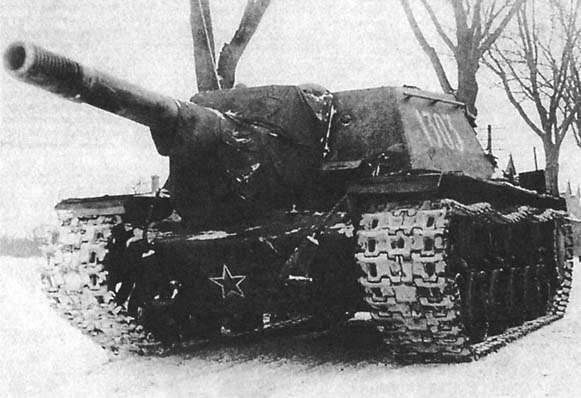
The base for the ACS was a heavy KV-1С tank, while the Su-152 was almost the same as the tank for protection. The thickness of the frontal armor of the cabin was 75 mm, the hull forehead was 60 mm, and the hull and wheelhouse side board was 60 mm. The combat weight of the vehicle is 45,5 T, the crew is 5 people, including two loaders. The introduction of two loaders was due to the fact that the weight of the high-explosive fragmentation projectile exceeded 40 kg.
The serial production of ACS SU-152 lasted until December 1943, and ended simultaneously with the cessation of production of the KV-1С tank. The number of built SU-152 in different sources is indicated differently, but most often the figure of 670 appears.
The most active self-propelled guns were used on the front in the period from the second half of the year 1943 to the middle of the year 1944. After the termination of the release of the KV-1С SAU SU-152, the troops replaced the units based on a heavy IS tank. Compared with self-propelled tanks SU-152, they suffered less losses from anti-tank artillery and enemy tanks, and therefore many heavy SAUs were written off due to resource development. But some of the cars that have undergone a refurbishment, participated in hostilities before the surrender of Germany.
The first SU-152 entered the troops in May 1943 of the year. Two heavy self-propelled artillery regiments for 12 ACS in each took part in the battle near Kursk. Contrary to popular myths, due to the small number of special influence on the course of hostilities, they did not have there. During the battle on the Kursk Bulge, self-propelled guns were usually used for firing from closed firing positions, and, moving behind tanks, gave them fire support. Due to the fact that there were few direct collisions with German tanks, the losses of the SU-152 were minimal. However, there were cases of firing at enemy tanks direct fire.
Here is what the battle report for 8 July 1943 of the 1529 TSAP, which was part of the 7 Guards Army of the Voronezh Front, says:
Based on the above combat reports, we can draw two conclusions. First, it should be noted a good shooting performance and low consumption of projectiles: for example, in the first combat episode of 12 high-explosive fragmentation grenades were hit with 9 targets. Secondly, based on other combat episodes, it can be assumed that the enemy, having fallen under heavy weapon shelling, retreated faster than the SAU crews managed to completely destroy it. Otherwise, the consumption of shells could be significantly higher. That however, does not detract from the combat value of heavy self-propelled guns.
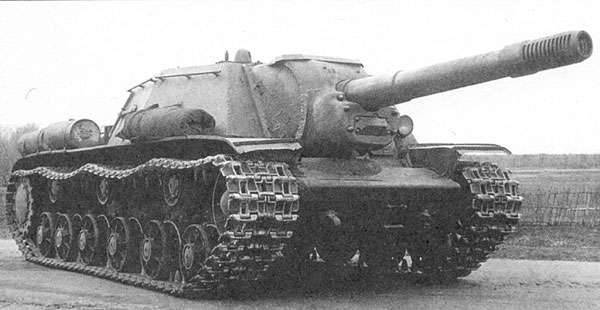
Reports on the results of the fighting among the armored vehicles destroyed by the crews of the SU-152, repeatedly appear heavy tanks "Tiger" and PT SAU "Ferdinand". It is fair to say that shooting even 152-mm high-explosive fragmentation projectile at German tanks gave a very good result, and for the withdrawal of enemy armored vehicles from the system, a direct hit was not always required. As a result of a close gap, the running gear was damaged, observation devices and armament were knocked out, and the tower was wedged. Among our soldiers, SU-152 self-propelled guns deserved a proud name - “St. John's Wort”. Another question is how it was really deserved. Of course, the armor of a single German tank could not withstand a hit by an armor-piercing projectile fired from an 152-mm howitzer cannon. But, given that the ML-20 direct shot range was about 800 meters, and the firing rate did not exceed 2 rounds / min at best, SU-152 could successfully act against medium and heavy tanks armed with long-barreled guns with high rate of fire, from ambush.
The number of destroyed "Tigers", "Panther" and "Ferdinadov" in the summaries of the hostilities and in the memoir literature many times exceeds the number of these machines built in factories in Germany. As a rule, screened "fours" were called "Tigers", and all German self-propelled guns were called "Ferdinands".
After the capture at the beginning of 1943, near Leningrad, the German tank Pz.Kpfw. VI "Tiger" in the USSR began to hastily create tanks and self-propelled guns armed with guns capable of fighting with enemy heavy tanks. Tests at the site showed that the 85-mm anti-aircraft gun can cope with medium-distance armor at the Tiger. Designer F.F. Petrov created a tank X-NUMX-mm gun D-85 with ballistic data of anti-aircraft guns. Option D-5S armed with PT SAU SU-5. The angle of elevation of the gun from −85 ° to + 5 °, the sector of horizontal shelling was ± 25 °. Direct firing range - 10 km, maximum range - 3,8 km. Due to the use of unitary shots, the rate of fire was 12,7-5 shots / min. The Su-6’s ammunition contained 85 shells.
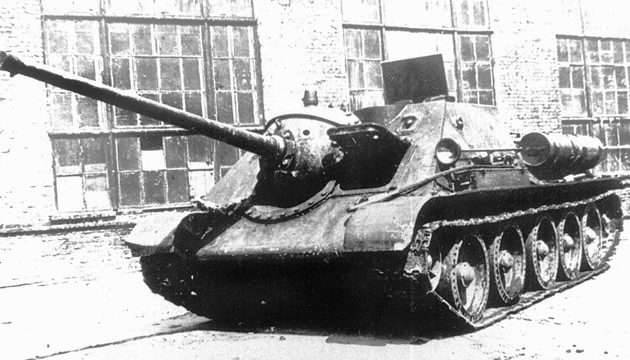
The machine was created on the basis of the SU-122, the main differences were mainly in armament. Production of the SU-85 began in July 1943, and did not have time to take part in the battles at the Kursk Bulge. Thanks to the use of a well-developed SU-122 case, it was possible to quickly establish mass production of anti-tank self-propelled guns SU-85. In terms of security, the SU-85, just like the SU-122, was at the level of the medium T-34 tank, the armor thickness of the tank destroyer did not exceed 45 mm, which was clearly not enough for the second half of the 1943.
The ACS SU-85 entered separate self-propelled artillery regiments (SAP). In the regiment there were four batteries with four installations in each. SAPs were used as part of fighter anti-tank artillery brigades as a mobile reserve or attached to small units to enhance their anti-tank capabilities, where often infantry commanders were used as line tanks.
Compared with the 85-mm anti-aircraft gun 52-K range of ammunition in the ammunition ammunition was much higher. O-365 fragmentation grenades weighing 9,54 kg after mounting the fuse on a high-explosive action could successfully be used against enemy fortifications. An armor-piercing tracer with a ballistic tip 53-BR-365 weighing 9,2 kg, with an initial speed of 792 m / s at a distance of 500 meters normal pierced through 105 mm armor. This made it possible to confidently hit the most common medium-sized German tanks Pz.IV of later modifications at all real combat distances. If you do not take into account the Soviet heavy tanks KV-85 and EC-1, which were built a little, before the appearance of the T-34-85 tanks, only SAU SU-85 tanks could effectively deal with the average enemy tanks at distances of over a kilometer.
However, the first months of combat use of the SU-85 demonstrated that the power of 85-mm guns was not always sufficient to effectively counter the enemy’s heavy tanks, Panther and Tiger, which, with effective sighting systems and security advantages, imposed a long-range battle. . A sub-caliber BR-365P projectile was well suited for fighting heavy tanks; at a distance of 500 m along the normal, he pierced armor with a thickness of 140 mm. But sub-caliber projectiles were effective at relatively short distances, with an increase in the range of their armor penetration characteristics dropped sharply.
Despite some shortcomings of the SU-85 in the army were loved, and this self-propelled gun was very popular. A significant advantage of the SAU, compared with the T-34-85 tank, which appeared later, armed with a gun of the same caliber, had better working conditions for the gunner and charging in a more spacious fighting room than the tank tower. This reduced crew fatigue and increased the practical rate of fire and accuracy of the fire.
In contrast to the SU-122 and the SU-152, the anti-tank SU-85, as a rule, operated in the same battle formations together with the tanks, which is why their losses were very significant. From July 1943 to November 1944, military acceptance of the 2652 industry took combat vehicles, successfully used until the end of the war.
In 1968, according to the story of the writer V.A. Kurochkina "In war as in war" about the commander and crew of the SU-85 was shot a wonderful film of the same name. Due to the fact that all SU-85 had been written off by that moment, SU-100, which was then in the Soviet army, was still in its role.
6 November 1943, the decision of the State Defense Committee adopted a heavy assault ACS IAM-152, created on the basis of a heavy tank "Joseph Stalin". In the production of ISU-152 replaced the SU-152 based on the KV tank. Armament self-propelled guns remained the same -152,4-mm howitzer gun ML-20 with arr. 1937 / 43 The gun was induced in a vertical plane ranging from −3 to + 20 °, the sector of horizontal pickup was 10 °. The range of a direct shot at the target height 2,5 m - 800 m, the range of direct fire - 3800 m. The real rate of fire 1-2 rds / min. Ammunition was 21 shot separately-cartridge loading. The number of crew members remains the same as in SU-152 - 5 people.
Compared with its predecessor, the SU-152, the new ACS was much better protected. The most massive in the second half of the war was the German 75-mm anti-tank gun Pak 40 and the guns of medium tanks Pz. IV at distances greater than 800 m could not penetrate the frontal 90 mm armor that had a slope 30 ° with an armor-piercing projectile. The habitability conditions of the ISU-152 combat unit became better, the crew’s work became somewhat easier. After identifying and eliminating “childhood diseases”, the self-propelled gun showed unpretentious maintenance and a fairly high level of technical reliability, surpassing the SU-152 in this regard. ISU-152 was sufficiently maintainable, often self-propelled guns that received combat damage were returned to service several days after repair in field workshops.
The mobility of the ISU-152 on the ground was the same with the tank EC-2. Reference books indicate that self-propelled guns on the highway could move at a speed of 40 km / h, while the maximum speed of a heavy tank IS-2, weighing the same 46 tons, is only 37 km / h. But in reality, heavy tanks and self-propelled guns moved on roads with hard surface at a speed of no more than 25 km / h, and on rough terrain 5-7 km / h.
The main purpose of ISU-152 at the front was the fire support of the advancing tank and infantry units. 152,4-mm high-explosive fragmentation shell OF-540 weighing 43,56 kg, containing about 6 kg of trotyl with a fuse set for fragmentation effect, was very effective against unarmored infantry, the installation of a fuse on a high-explosive action against the bunkers, billets, bunkers, armored ceilings and capital brick buildings. One hit of a projectile fired from a ML-20C cannon into a three-four-storey medium-sized city house was often enough to destroy all living things inside. ISU-152 turned out to be especially in demand when the assault turned into fortified areas of the city blocks of Berlin and Königsberg.
Heavy ACS IMS-152 inherited from its predecessor the nickname “St. John's wort”. But in this field, the heavy assault self-propelled gun was significantly inferior to the specialized PTs of the ACS, armed with high-ballistic guns and 6-8 gunshots / min. As already mentioned, the range of a direct shot of an ISU-152 gun did not exceed 800 meters, and the firing rate was only 1-2 shots / min. At a distance of 1500 meters, an armor-piercing projectile 75-mm cannon KwK 42 of a German tank "Panther" with a barrel in 70 calibers pierced the frontal armor of the Soviet self-propelled gun. With the fact that German tankers on 1-2 Soviet 152-mm projectile could respond with six aimed shots, engage in direct fights with heavy enemy tanks at medium and large distances was, to put it mildly, not reasonable. By the end of the war, Soviet tankers and self-propelled guns had learned to correctly select positions for anti-ambush, acting for sure. Careful disguise and quick change of firing positions helped to achieve success. In the offensive, the low rate of fire of 152-mm guns was usually compensated for by the coordinated actions of a group of 4-5 ACS. In this case, with a head-on collision, the German tanks that were not numerous at that time had almost no chance. According to archival data, from November 1943 to May 1945, the 1885 self-propelled guns were built, production of the IMS-152 was completed in 1946 year.
In 1944, the production of MIS-152 was largely hampered by a shortage of ML-20C tools. In April, the 1944 of the year began the serial assembly of the ACS IMS-122, which were armed with an X-NUMX-mm A-122-C gun with a barrel-length 19 caliber. These tools were in abundance in the warehouses of artillery weapons. Initially, the A-48C had a piston-type shutter, which significantly limited the rate of fire (19 — 1,5 shot per minute). In self-propelled ammunition there was 2,5 shots of separate-cartridge loading. As a rule, these were 30 high-explosive and 25 armor-piercing shells. This ratio of ammunition reflected the purpose for which self-propelled guns often had to fire.
In the autumn of 1944, the ACS IMS-122С with the 122-mm self-propelled version of the D-25С gun equipped with a semi-automatic wedge gate was launched into the series. The D-25C firing rate reached 4 rds / min. In terms of this indicator, the self-propelled gun, thanks to the better working conditions of the loaders and the more spacious layout of the combat compartment, was superior to the heavy tank EC-2, which was armed with a practically similar D-25T gun. Visually, the ISU-122 from the ISU-152 was distinguished by a longer and thinner gun barrel.
ISU-122 proved to be even more versatile and demanded by car compared to ISU-152. The good rate of fire, the high direct shot range and the great power of the projectile action made it equally effective both as a means of artillery support, and as a highly effective PT SAU. At the front, there was a kind of “division of labor” between MIS-152 and MIS-122. 152-mm guns were used as assault, operating in cities and on cramped roads. ISU-122 with its longer gun was difficult to maneuver on the streets. They were more often used for breaking through fortified positions in open areas and for firing from closed positions in the absence of towed artillery in case of fast breaks when the towed guns did not have time to move past the tank and mechanized units of the Red Army. In this role, the great firing range exceeding 14 km was especially valuable.
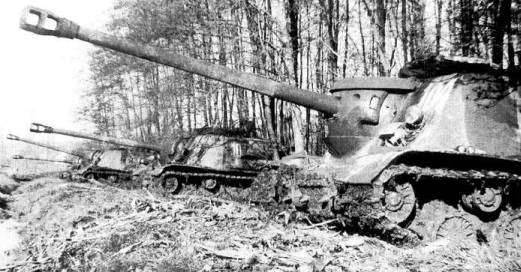
The characteristics of the ISU-122С instrument made it possible to fight with the enemy’s heavy tanks at all available combat distances. 25-kg BR-471 armor-piercing projectile, leaving the barrel of the D-25 gun with an initial speed of 800 m / s, pierced the armor of any German armored vehicle model, except for the Ferdinand self-propelled artillery unit. However, without a trace for the German self-propelled gun a blow to the frontal armor did not pass. Chips occurred from the inner surface of the armor, mechanisms and aggregates broke down from powerful shaking. The high-explosive steel grenades OF-471 and OF-471Н had a good striking effect on bronzesels when the fuse was set to a high-explosive effect. The kinetic strike and the subsequent explosion of 3,6 — 3,8 kg of TNT, as a rule, was enough to bring the enemy's tank down without even breaking through the armor.
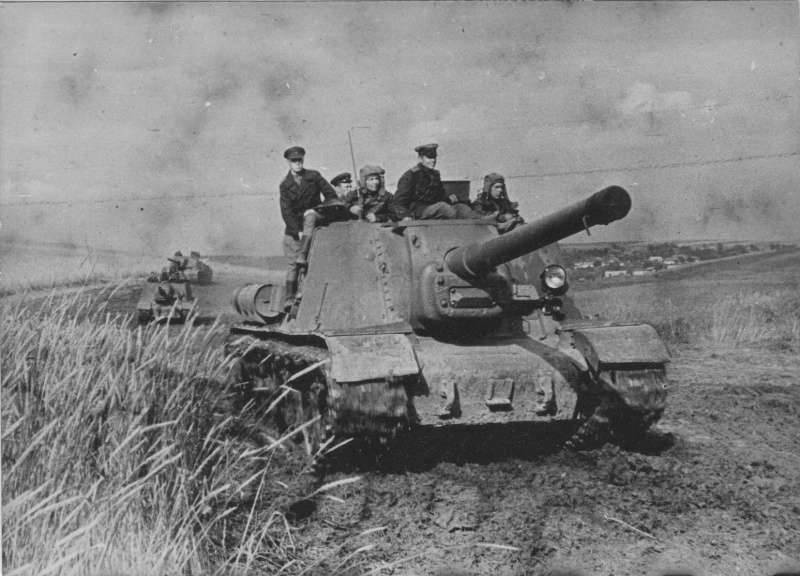
MIS-122 of all modifications were actively used at the final stage of the war as a powerful PT and assault ACS, playing a large role in the defeat of Germany and its satellites. In total, the Soviet industry delivered 1735 self-propelled guns of this type to the troops.
Talking about Soviet self-propelled installations with 122-152-mm caliber guns, it can be noted that they, despite the available opportunity, rarely fired from closed positions. This was mainly due to the lack of knowledge of the crews of ACS for effective fire from closed positions, an insufficient number of trained spotters, lack of communications and location control. An important circumstance was the consumption of shells. The Soviet command considered that it was easier and more profitable to accomplish the combat task of firing direct fire, firing several 152-mm projectiles, albeit with the risk of losing the vehicle and crew, than wasting hundreds of projectiles with an unobvious result. All these factors caused the fact that during the war years all our heavy self-propelled artillery mounts were designed for direct fire, that is, they were assault.
Lack of security and not always satisfying the military power of the armament of the tank guns SAU SU-85 caused the creation of self-propelled guns with 100-mm guns of unitary loading. The self-propelled unit, designated SU-100, was created by the designers of Uralmashzavod in 1944 year.
The results of the shelling at the landfill of captured German tanks demonstrated the low effectiveness of 85-mm shells against high hardness installed at rational inclination angles of German armor. Tests have shown that for confident defeat of heavy German tanks and self-propelled guns, an instrument with a caliber of at least 100-mm was required. In connection with this, it was decided to create a tank gun using unitary shots of the 100-mm naval universal gun with high ballistics B-34. At the same time, a new SAU hull was designed on the chassis of the medium tank T-34. The thickness of the upper, most vulnerable from the point of view of the probability of hitting shells, part of the frontal armor was 75 mm, the angle of inclination of the frontal sheet was 50 °, which in ballistic resistance exceeded 100 mm armor sheet installed vertically. Significantly increased in comparison with the SU-85 security allowed to confidently resist the penetration of projectiles from 75-mm anti-tank and guns of medium tanks Pz. Iv. In addition, the SU-100 had a low silhouette, which significantly reduced the likelihood of hitting it and made it easier to disguise while in the shelter. Thanks to the well-developed base of the T-34 self-propelled gun after the start of deliveries to the troops, there were almost no complaints about the level of reliability, their repair and restoration in front-line tank repair shops did not cause difficulties.
According to the experience of military operations and, taking into account the numerous wishes of the Soviet tank crews and self-propelled guns, a commander's turret, similar to that used on the T-100-34, was introduced on the SU-85. An overview of the turrets was provided by the periscope viewing device MK-4. Along the perimeter of the commander's turret there were five viewing slots with quick-change protective triplex glass blocks. The presence of a fairly good overview of the battlefield at the SAU commander made it possible to timely detect targets and control the actions of the gunner and the driver.
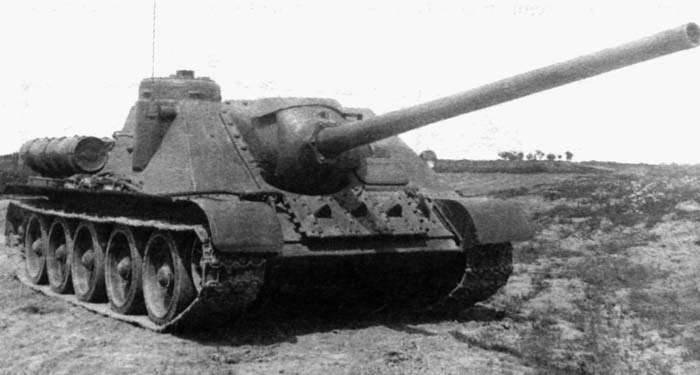
When designing the SU-100, initially, certain attention was paid to the ergonomics and living conditions in the combat compartment of the new self-propelled guns, which was uncharacteristic of the Russian tank design during the war years. Although, of course, the level of comfort typical of Allied armored vehicles, and partly Germans, was not achieved for the four crew members, and the situation inside the self-propelled gun was Spartan. The Soviet self-propelled guns SU-100 were very fond and were perceived as a punishment for transferring to another vehicle.
The combat weight of the SU-100 due to the abandonment of the turret, even with better security and larger-caliber guns, was about half a ton less than the T-34-85 tank, which had a beneficial effect on mobility and maneuverability. However, the self-propelled mechwaters had to be very careful when driving on very rough terrain, so as not to “scoop” the ground with a relatively low long-barreled gun. Also for this reason it was difficult to maneuver in the narrow streets of European cities.
In preparation for the start of mass production of the SU-100, it turned out that the supply of self-propelled units to the troops was hampered by an insufficient number of existing 100-mm guns. In addition, the enterprises of the People's Commissariat of Ammunition failed to promptly launch the production of 100-mm armor-piercing shells. In this situation, as a temporary measure, it was decided to install X-NUMX-mm D-85С guns on new self-propelled guns. The ACS with the 5-mm gun in the new case was designated the SU-85M. In 85, 1944 of such installations was built.
SAU SU-100 was armed with X-NUMX-mm cannon D-100-arr. 10 g. With a barrel length 1944 gauges. In the vertical plane, the gun was induced in the range from −56 to + 3 °, and in the horizontal 20 °. The D-16C cannon, which proved to be exceptionally powerful and effective, could fight all types of enemy heavy armored vehicles. After the war, tank T-10 and T-10 tanks, which are still used in many countries, were armed with tank versions of the D-54T.
The direct range of an 53-BR-412 armor-piercing projectile against a target with a height of 2 meters was 1040 meters. At a distance of 1000 meters, this projectile, weighing 15,88 kg, pierced the normal 135 mm armor. The high-explosive fragmentation shell of the RP-412 15,60 kg mass contained 1,5 kg of TNT, which made it an effective means of destroying field fortifications and destroying enemy personnel. In the ammunition Su-100 there was a 33 shot unitary loading. Typically, the ratio of high-explosive and armor-piercing shells was 3: 1. The combat rate of fire with the coordinated work of the gunner and loader reached 5-6 rds / min.
From September 1944 to May 1945, the troops were transferred around 1500 SU-100. The enemy very quickly appreciated the security and firepower of the new Soviet SAU, and German tanks began to avoid a frontal collision with them. Landing and mobile ACS with 100-mm guns, due to higher rate of fire and long-range direct shot, were even more dangerous opponents than heavy EC-2 tanks and self-propelled guns with 122 and 152-mm guns. According to combat characteristics, the closest German analogue of the SU-100 is the SAG Jagdpanther, but they were built three times smaller during the war.
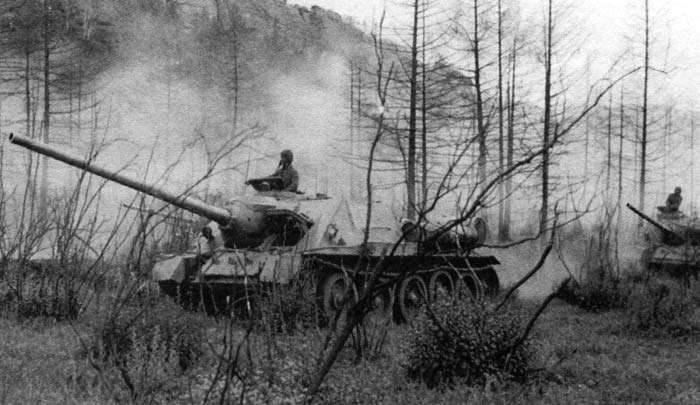
The most notable role of the SU-100 was played during the Balaton operation; they were very effectively used by the 6-16 of March of the 1945 of the year in repelling counterattacks of the SS 6 Panzer Army. Self-propelled guns of the 207, 208 and 209 self-propelled artillery brigades, as well as several separate SAPs took part in the battles. During the operation, SU-100 proved to be a highly effective means in the fight against German heavy armored vehicles.
It was SU-100 that became real “Hunters”, although for some reason in memoir, “okolodokumentumentalnuyu” and fiction, these laurels are given heavy SU-152 and ISU-152, much less likely to enter into firing duels with German tanks. Given the post-war production, the number of SU-100 built exceeded 3000 units. In the 50-70-s, these self-propelled guns were repeatedly upgraded, and in our country were in service until the beginning of the 90-s.
Based on:
http://ww2history.ru/soviet_sau.html
M.N. Svirin. Artillery armament of Soviet tanks 1940 — 1945. - M .: Exprint, 1999
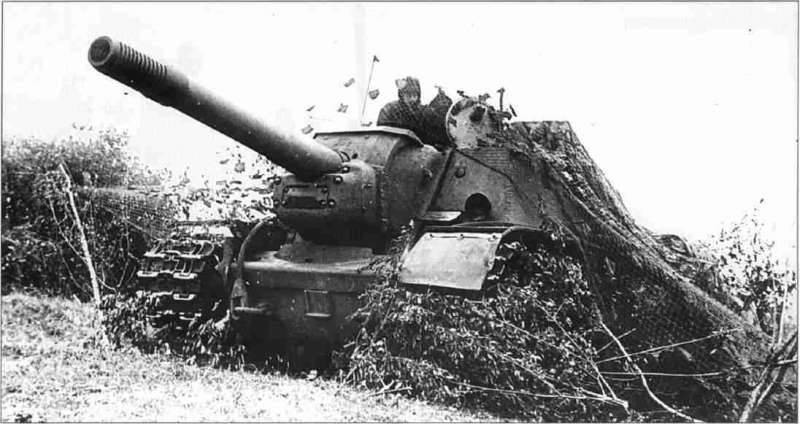
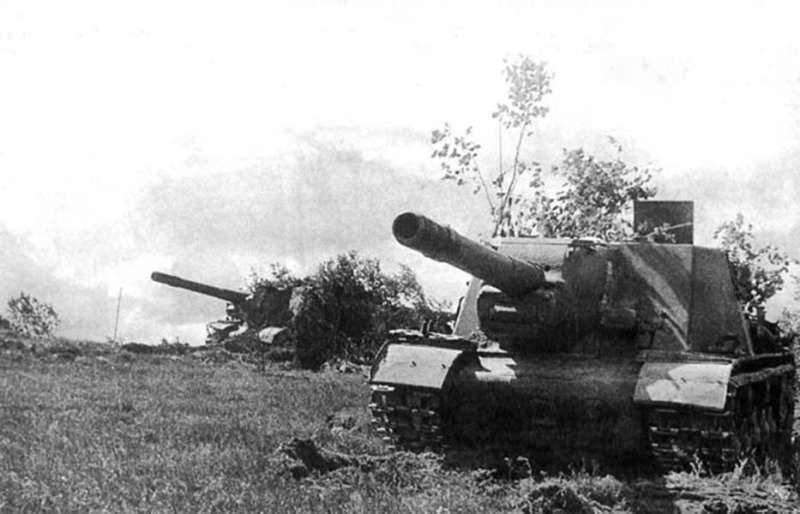
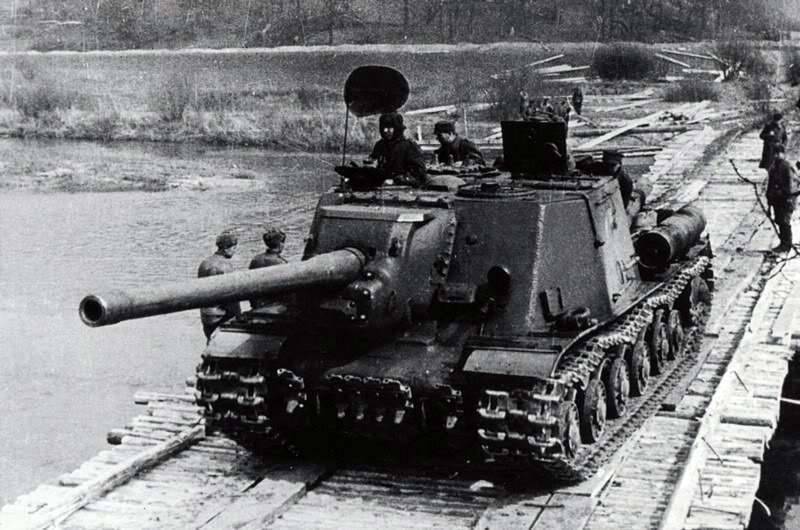
Information